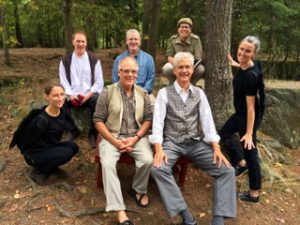Wednesday
Arts and PoetryInterview with a Shambhala Playwright
 This Harvest of Peace weekend, a new Shambhala play, Norbu and the Mystery of the Missing Ratna, will premier at the Halifax Shambhala Centre and a theatrical featurette about the play is being made available to all local Shambhala centres for the Harvest of Peace celebrations. The Shambhala Times had a few questions for the playwright about this new artistic endeavor.
This Harvest of Peace weekend, a new Shambhala play, Norbu and the Mystery of the Missing Ratna, will premier at the Halifax Shambhala Centre and a theatrical featurette about the play is being made available to all local Shambhala centres for the Harvest of Peace celebrations. The Shambhala Times had a few questions for the playwright about this new artistic endeavor.
Shambhala Times: What’s Norbu and the Mystery of the Missing Ratna about?
Walker Blaine: The play is a comedy about a man named Norbu McBurns who lives in a mountain village near the mythical kingdom of Shambhala. Norbu cares for a little garden in the mountains above the village, The Rigden’s Garden. The townspeople know the stories of Shambhala, but most see them as fairy tales. One afternoon in the garden, Norbu meets someone actually from Shambhala, a minister on an errand for the Rigden, the ruler of the Shambhala kingdom. Later in the day, Norbu returns and finds that the minister forgot a sealed package—a ratna, the gold coin of the kingdom. This begins a quest: Norbu must to return the ratna to its owner, the Rigden King.
ST: How did the play come about?
WB: During a short retreat last spring in Nova Scotia, a thought popped into my head—the feeling of the play, like a little light turning on. During breaks I outlined the plot and realized it was a five-act comedy. After the retreat I wrote up all the dialogue, which took about 3 weeks in between other events of daily life. But it was really easy. I should add that after we got into the rehearsal process, all the cast made great suggestions about the dialogue, and seeing it coming alive allowed me to make changes too. It’s been pretty organic.
ST: Where did you get the idea?
WB: It came out of nowhere—you know, where do thoughts come from? But when I think about it, there are a few main sources. One was the Epic of Gesar of Ling. A year or two ago, my wife and I started reading and singing it aloud, just making up melodies. We had people over for beers and did that together. We got to tell the Sakyong Wangmo about this, and she said they did that in her family too. The Gesar Epic is funny and provocative. It’s a lot easier to understand what’s going on if you just sing it because it is very profound. Singing slows down the cognitive mind—beer might also have affected things a little too.
The other major source of inspiration has been the Shambhala teachings and Buddhism altogether. The play’s about basic goodness in a big way—what it’s like to find it and what it’s like to be around others experiencing it—humans, gods, and animals.

Cast of the theatrical featurette: Back Row: John Odenthal, Walker Blaine, Anna Weinstein, Front Row: Julia Sable, Tim Walker, David Brown, Brin Jones
ST: Will you take it on the road? Will you film the play?
WB: It’s been an all-volunteer effort. The cast of 17 is playing 22 parts, and to tell you the truth, even though we’ve been in rehearsal for more than two months, we’ve never had everyone in the same place at the same time even once. Even during the three performances, we have had to change the cast because everyone is so busy. So a road show would be impossible.
But I want the play itself to go on the road. It’s possible for centers to have their own productions, and the play can be done as a stage-reading, with people holding their scripts, which is a lot easier than memorizing everything. I will put the pdf on sale in a few weeks, and if centers want to put on the play, there will be a production version of the script as well, with notes and permission to make lots of copies. We’ll keep costs low, by the way.
ST: What’s next?
WB: Well, I hope to quietly go back to my ordinary life after this. I didn’t realize what I was getting into. Putting on a totally new play is like waking up finding a full-grown Tibetan Mastiff, an English Sheepdog, and a Newfoundland dog all living with you. That’s not the cast, by the way—their names are Production, Directing, and Editing. But after a while, you find everyone wants to walk the dogs along with you and it’s not so bad.
I offered the Sakyong a rough draft of the play in the summer. His response was to say that we need more things like this—more art and creativity based on goodness. The Druk Sakyong said Shambhala art would be the biggest gate into enlightened society. I know I am not alone in wanting to make things like this. As both Sakyongs have said, the dralas are waiting to help us.
Walker Blaine has been a member of the Shambhala community for over 30 years. After receiving a bachelor’s degree from Naropa University in Colorado, he spent 15 years working and meditating at Shambhala’s rural retreat centers, and then 6 years concentrating on study, retreat, and pilgrimage to Buddhist sacred places in Asia and the West.
Since 2008 Walker has resided in Halifax with his wife Patricia. He is a production editor at Kalapa Media and is Master of Liturgies to Sakyong Mipham Rinpoche. Walker has created two CDs of Buddhist and Shambhala music, which are available on iTunes.
Editor’s Note: Want to see the trailer for this play? Just keep an eye on the Times…..





